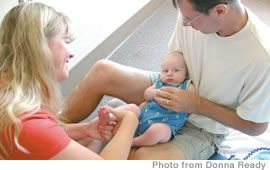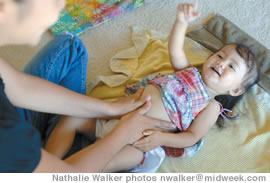How About A Nice Massage, Baby?
Massages aren’t just for stressed out adults. They’re also a way of showing a baby love

By .(JavaScript must be enabled to view this email address)
E-mail this story | Print this page | Archive | RSS

Donna and Derrik Ready massaging son Zachary at
Queen’s Medical Center’s baby massage and
exercise class
Infant massage helps babies grow, develop better and even aids in curing common baby ailments. Besides, it’s just plain fun to touch your baby.
So after reading countless studies confirming that touched babies thrive, I loaded up my 1-year-old and headed to Moku Ola Healing Center for a baby massage class.
The lomilomi (Hawaiian massage) techniques were fairly easy to learn and remember, even for someone with no experience. In our first class we learned the importance of massage and basic massage techniques, followed by some Q&A and chit-chat among the mothers.
“I think the main thing is bonding,” says Aoi Wright of Moku Ola Healing Center. “That’s something we sometimes don’t have these days because everyone is so busy working. It’s that bonding experience that they really need for their growth. I think that’s the No. 1 thing for us. Circulation too. It helps baby eat better, which means a happier baby.

The author lomilimi s daughter Kylie
“This gives us an opportunity to share what we know. We’ve been doing it for so long that we know it works. What makes it special is the lomilomi itself is special. We live it, and to instill it into a child and to create that openness and caring ... it’s an amazing gift that you can give someone.”
In the second class, moms practiced the techniques to soothe and bond with their babies, and even learned a few more lomilomi techniques. The third class focused on how to use lomilomi to soothe a colicky baby and help correct a huli opu (sore stomach). The fourth session wrapped up with more practice on huli opu and a review of everything learned.
“The classes teach parents how to keep baby healthier and prevent illness through massage, which is a combination of getting the toxins out, but it’s also great because of the bonding experience,” adds Piilani Wright of Moku Ola Healing Center. “It helps the digestive flow, and gas. Eventually it teaches the child that massage is something to maintain and to take care of you. Lomilomi is to malama, take care of that person.”
As studies show and Aoi and Piilani confirm, baby massage is beneficial for baby’s development and even helps with common baby ailments such as colic, upset stomach, circulatory problems, restlessness and gas. In fact, in some Eastern societies a mother is reprimanded if she doesn’t give her baby a daily massage - and for good reason.

Aoi Wright shows Dayna Hagihara how much pressure
to use when massaging her baby, Jordan Ahn-
Nicholson
Massage is relaxing, soothing, reduces muscle tension, aids in digestion, stimulates circulation, reduces stress - and that does-n’t even touch on the added benefits just for baby. For babies, massage also strengthens bonding, establishes loving communication, promotes self-esteem and provides security.
In short, the benefits of baby massage aren’t limited to the physical feel-good factor that we adults love about getting massages. Baby massage also has emotional, psychological and long-term benefits.
Research has shown that touch may even be as important to a baby’s physical, emotional and cognitive development as eating and sleeping. In fact, scientific studies show that babies who are touched more grow faster and start crawling, walking and grabbing earlier. They are also more alert and active, sleep more soundly, and develop stronger immune systems and higher IQs.
That doesn’t mean massaging your baby ensures perfect health and an off-the-chart IQ, but they’re all good reasons for parents to make massage part of their daily routine.
While most adults have some experience massaging other adults, the question then becomes, so how is massaging a baby different than an adult?
Aside from the obvious size factor, the biggest difference is that babies are not able to verbally communicate what they like and don’t like, so the challenge then becomes reading and understanding their cues. Then with the proper massaging techniques, the right applied pressure, perhaps some pure lavender oil and a warm, quiet place, the baby massaging can commence.
“I think for most parents, because massaging an infant is something new to them, that they’re probably nervous, so they won’t do it because of fear that they’ll do something wrong,” says Piilani. “So going to a class helps to ease their mind. We show basic routines and massage. It’s more for peace of mind to know that they are doing it right so they are not afraid to do it.”

Everybody loves a foot massage
Moku Ola’s classes accept babies of any age. The classes at Queen’s Medical Center, however, focus on babies from 2 to 6 months old.
“I’ve had some babies 6 to 8 months. However, I found it easier to learn the massage on babies who aren’t mobile,” says Tracy Carlson, (CIMI) certified infant massage instructor with an MED. “I think it’s great to take classes when the babies are younger because there’s also sleep benefits and helps to give baby the rest that your baby needs.”
The classes teach a full routine massage, an abbreviated massage and a gas and colic series, which is a sequence of strokes that helps the baby relax his or her stomach.
“Overall the class is for a family, so it can be mom and dad or mom, baby and caregiver, grandparent,” says Carlson. “The class is a place where they can learn to massage their baby and communicate with their baby, a place where they can be as a family together, communicate with their baby through touch and heart-to-heart-communication, and read baby’s cues and how they respond. Parents gets more attuned to their baby’s cues.”
The six-week course teaches different holding techniques and also covers how much pressure to apply in the massages. For the most part the strokes are fairly simple and even a bit fun.
“It was really just touching and bonding with my baby, and it did relax him as well,” says Donna Ready, wellness coordinator at Queen’s Medical Center and mother of Zach, now 8 months old. “He would be hyper sometimes, and he particularly liked the leg and foot massage. So we’ll do that in the nighttime as part of his nighttime ritual.”
So knowing all the great benefits, I now massage both my 1-year-old and 3-year-old daughters daily - my 1-year-old when she’s drinking her bottle, and my 3-year-old every night before bed. But there are moments while I sit on her bed massaging her feet that I wonder if I’ve created a pampered princess. I mean, what 3-year-old, after getting her feet massaged, says “Mom I want a full body massage”?
My husband jokes that it’s pay-back for the past years of having him massage me every night. Maybe pampered princesses run in the family.
INFANT MASSAGE CLASSES
Moku Ola Hawaiian Healing Center: Call 394-6658 or visit www.mokuolahawaii.com
Purple Yoga Hawaii: Call 944-8585 or e-mail .(JavaScript must be enabled to view this email address)
Queen’s Medical Center: Call 537-7117 or visit www.queens.org
Page 1 of 1 pages for this story
E-mail this story | Print this page | Comments (0) | Archive | RSS
Most Recent Comment(s):








